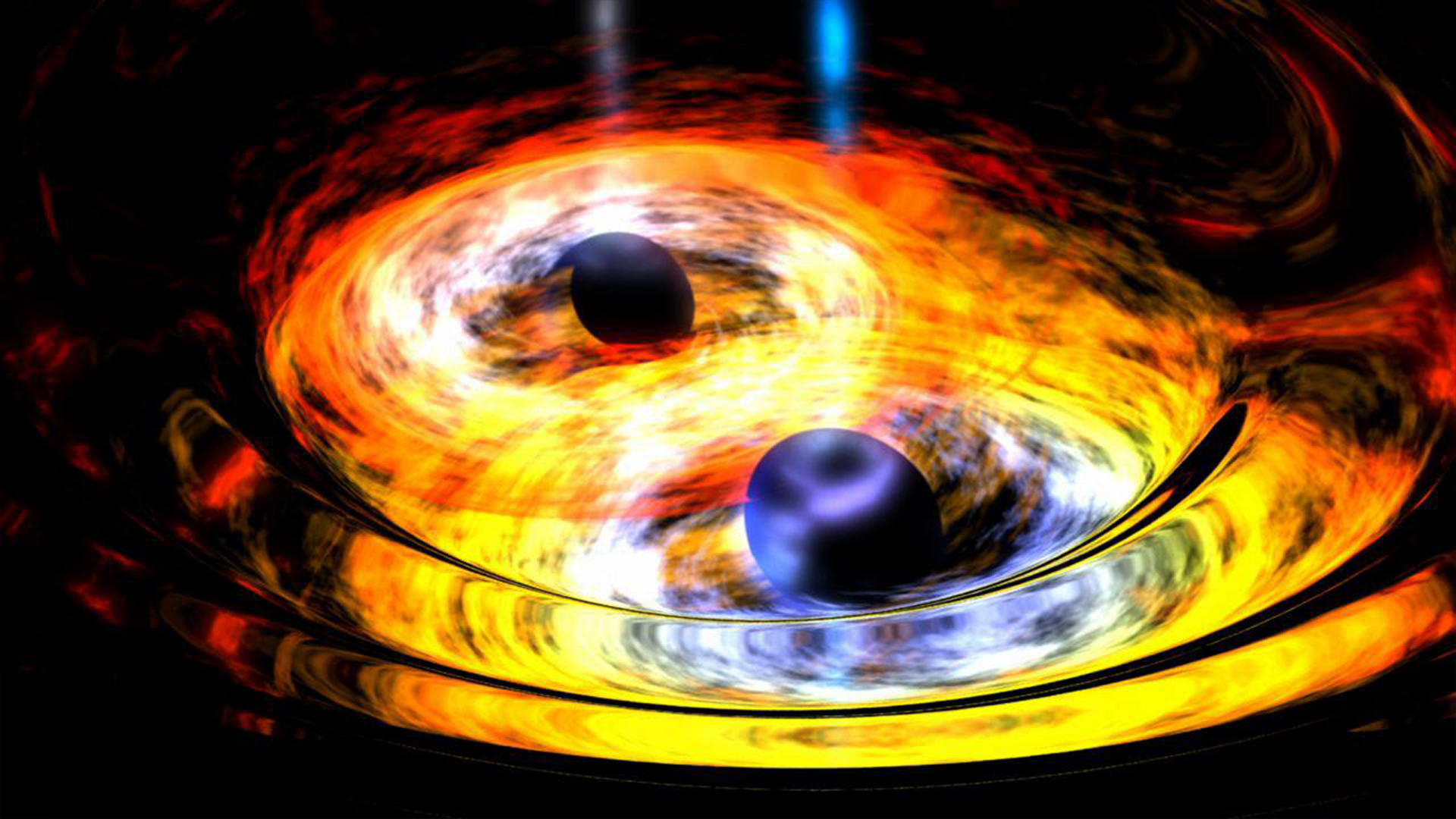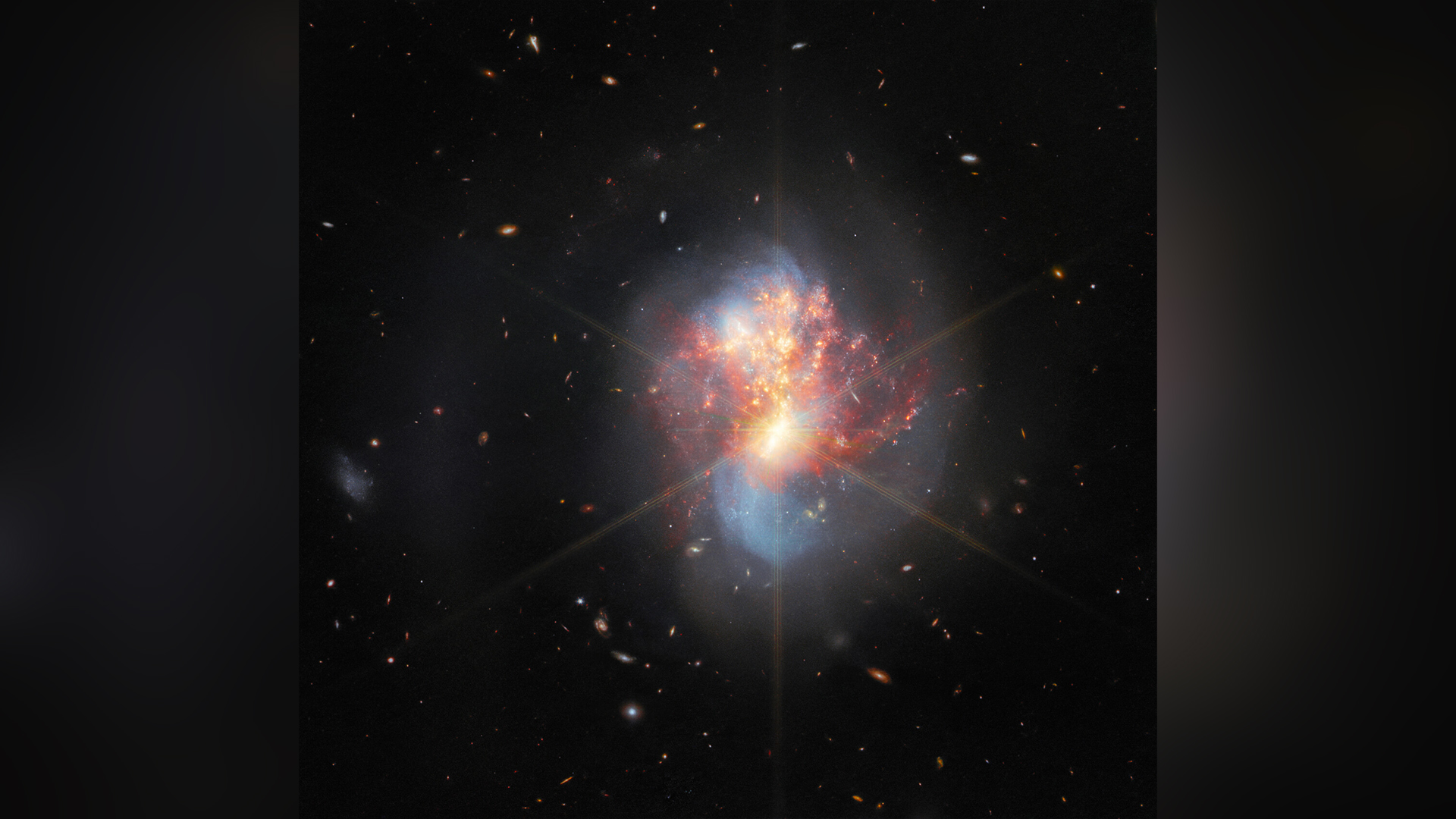Newly discovered black hole 'speed limit' hints at new laws of physics
When supermassive black holes recoil from a collision, they can reach speeds of up to 1/10th the speed of light, new research suggests.

Researchers have identified a new speed limit for the universe’s most extreme collisions. According to a study published in the journal Physical Review Letters, the "maximum possible recoil velocity" for colliding black holes exceeds a whopping 63 million mph (102 million km/h) — about one-tenth the speed of light. This peak occurs when the collision conditions are at the tipping point between the two black holes either merging together or scattering apart as they approach each other, according to the study authors.
Next, the researchers hope to mathematically prove that this velocity cannot be exceeded using Einstein's equations for relativity, posing potential implications for the fundamental laws of physics.
"We are just scratching the surface of something that could be a more universal description," study co-author Carlos Lousto, a professor of mathematics and statistics at the Rochester Institute of Technology (RIT) in New York, told Live Science. This newly discovered speed limit could be part of a larger set of physical laws that affect everything "from the smallest to the largest objects in the universe," Lousto said.
Quakes in the fabric of space-time
When two black holes pass close by each other, they will either merge or swerve around their common center of mass before flying apart. Whether the black holes fly apart or spiral into each other depends on their separation at the point of nearest approach.
To identify the maximum possible recoil speed of black holes flying apart, Lousto and study co-author James Healy, a research associate in the RIT School of Mathematics and Statistics, used supercomputers to run numerical simulations. These calculations stepped through the equations of general relativity describing how two interacting black holes will evolve. Lousto explained that although people began trying to solve these equations numerically more than 50 years ago, numerical techniques for predicting the size of gravitational waves from such collisions were not developed until 2005 — just 10 years before gravitational waves themselves were detected for the first time by the Laser Interferometer Gravitational-Wave Observatory(LIGO).
Since then, LIGO has observed nearly 100 black hole collisions. Comparing the data of one such collision with numerical relativity data revealed an "eccentric," or elliptical, black hole trajectory. Previously, scientists thought black holes approaching each other would spiral toward each other in near-circular orbits, Lousto said. The discovery of elliptical orbits broadened the range of possible collision events, and prompted them to look for extreme collision scenarios. "What we wanted to do is kind of push the limits of these collisions," said Lousto.
Get the world’s most fascinating discoveries delivered straight to your inbox.
Lousto and Healy looked at how adjusting four parameters affected the outcome of gravitational engagement between two black holes: the initial momenta of the black holes, the separation between them at the point of closest approach, the orientation of any rotation the black hole might have around its own axis, and the magnitude of that rotation.
By running 1,381 simulations — each of which took two to three weeks — the researchers found a peak in the possible recoil velocities for black holes with opposite spins grazing past each other. While black holes give out gravitational radiation in all directions, the opposing spins distort this radiation, creating a thrust that adds to the recoil velocity.
"The recoil of black holes after they merge is a critical piece of their interaction," Imre Bartos, Associate Professor in the Physics Department at the University of Florida, told Live Science via email. (Bartos was not involved in the new study). This interaction is especially significant for places in the universe with a high density of black holes, since large recoil kicks might expel a remnant black hole from the region altogether.
"As with every limiting theoretical quantity, it will be interesting to see whether nature exceeds this in some situation that could signal deviations from our understanding of how black holes work," Bartos added.
Related: Could a black hole devour the universe?
New fundamental physics
According to Lousto, the "tipping point" that determines whether two colliding black holes will merge or recoil is open to a bit of variability in the black holes' orbits. Because of this, Lousto likens this interaction to a smooth phase transition, like the second-order phase transitions of magnetism and superconductivity, as opposed to the explosive first-order phase transitions of heated water, for example, where a finite amount of latent heat is absorbed before it all boils. The researchers also glimpsed what might resemble the scaling factors characteristic of these phase transitions, although further high-resolution simulations are needed to identify these definitively.
Nonetheless, these aspects of the results hint at the possibility of "an overarching principle" that applies across scales from atoms to colliding black holes, Lousto said.
What is more, while marrying the two main pillars of fundamental physics — general relativity for gravity and quantum theory for the other fundamental forces — remains elusive, descriptions of black holes are closely tied to several theories that have opened chinks in the barriers between the two.
"This is far from rigorous proof," Lousto said. "But there is a line that deserves further research that maybe someone else or ourselves can make something of."

Anna Demming is a freelance science journalist and editor. She has a PhD from King’s College London in physics, specifically nanophotonics and how light interacts with the very small. She began her editorial career working for Nature Publishing Group in Tokyo in 2006. She has since worked as an editor for Physics World and New Scientist. Publications she has contributed to on a freelance basis include The Guardian, New Scientist, Chemistry World, and Physics World, among others. She loves all science generally, but particularly materials science and physics, such as quantum physics and condensed matter.




